Highland cattle
, The favourite thing at Home Lodge is the Highland cattle – the hielan coos! Yes the breakfasts are great, the views are amazing, the beds are unbelievably comfortable, but the cows win every time! As October ends, the temperatures are falling, the cattle are delighted the heat of summer is over and their winter coats are growing. So, it’s time for some Highland cattle information: their history, why we keep and love them and extreme cow watching at Home Lodge.
History of Highland Cattle
Sometimes called fluffy cows, hairy coos or hielan coos (Scottish for Highland cows)
Originating in the Highlands and the Outer Hebrides islands of Scotland, Highland Cattle have been living alongside man for thousands of years, with written record as far back as the year 1200-AD, and archeological finds that take them back to 1200-BC. They are a hardy breed, designed to withstand the conditions in the Scottish Highlands: cold, wet and windy.
Many crofters owned a “house cow” that would provide milk for the family. In winter it wasn’t unusual for the cows to come into the croft and their body heat helped warm the croft. This had the added benefit of also keeping others from stealing them.
Highland cattle were first imported into Canada in the 1880s to Manitoba and Nova Scotia.
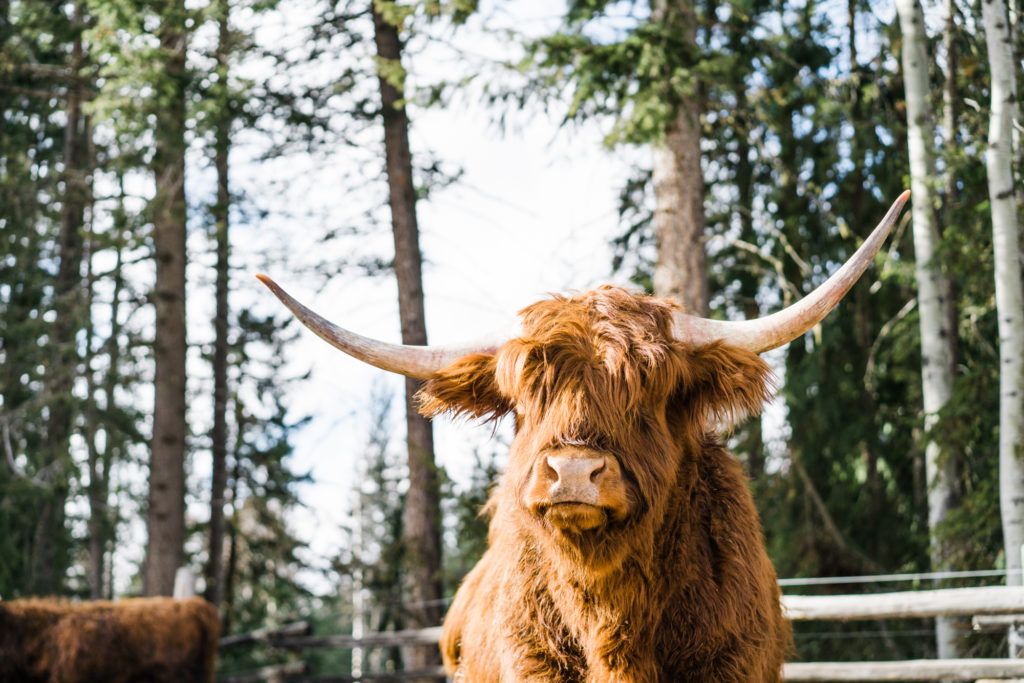
Spotting a Highland Cow
You can’t fail to spot a Hielan Coo – shaggy coats and beautiful horns.
Colours
The majority are shades of red but they come in all colours from white through to black. We have a few black and a rare silvery/grey dun colour in addition to red.
![]()
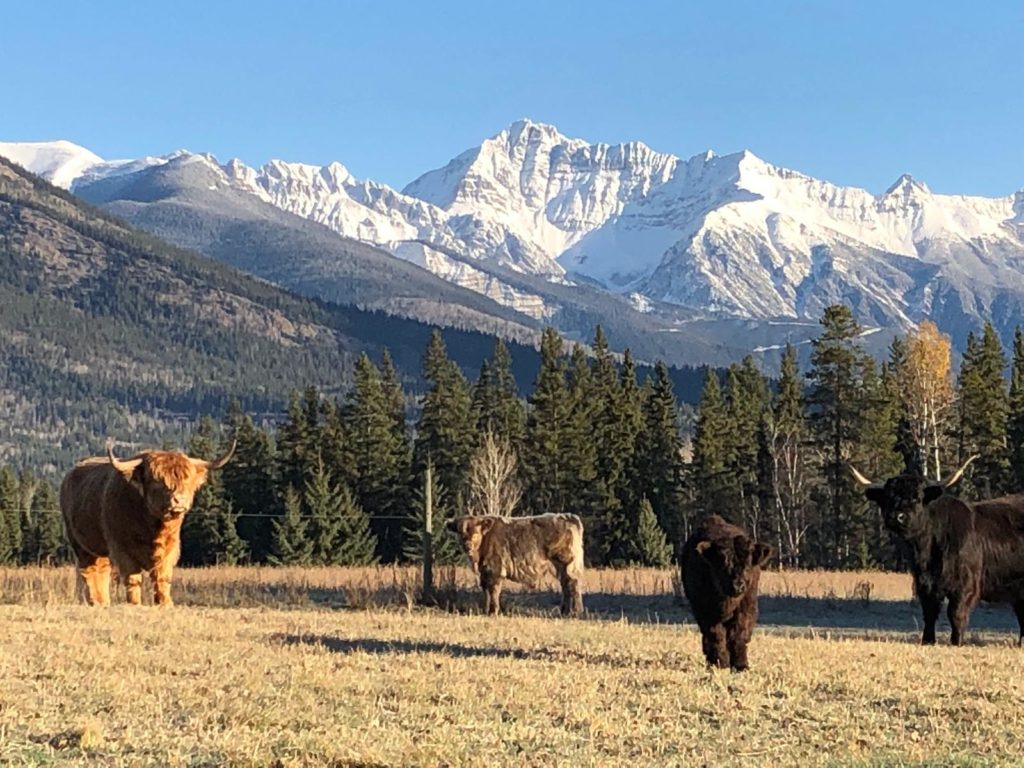
Horns
Both male and female have horns although if you look look they are slightly different shapes. A bull’s horns often grow forwards or even slightly downwards and have a much wider base, whereas a cow’s face upwards and are longer and finer at the tip. They know precisely where the tip of those horns are and they are used for scratching difficult to reach spots. The calves start growing horns pretty quickly and sometimes you see them rubbing their heads to ease the pressure as they push through.
Coat
Their distinctive long hair keeps them warm in winter, offers protection from the brush and undergrowth, protects their eyes from flies and it contributes to their stunning appearance which makes them so popular. Their long hair is actually an unusual double coat of hair – a long oily outer coat, the longest of any cattle breed, covering a downy undercoat. The meat of Highland cattle tends to be leaner than most beef because Highlands are largely insulated by their thick, shaggy hair rather than by subcutaneous fat.
They shed out their downy undercoat and the long hair gets shorter in Summer, especially in warmer climates – that’s why they are not as shaggy as they appear in Scotland.
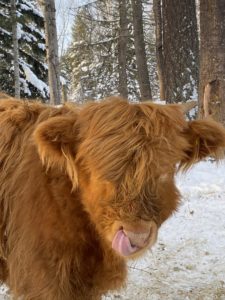
Why we keep Highlanders
Look at them! They’re gorgeous, but that’s not the only reason we keep them.
Temperament
They have a reputation for their fantastic temperament. They are known for being a very docile animal, never showing any aggression and are very low stress to keep and manage. Within their group they have a clear structure and hierarchy and never fight. Occasionally they will have a head to dead tussle to double check their order in the hierarchy, especially as they get bigger or if they’ve been separated for a while. They are very curious and will often approach people to see who they are. With this good nature does come protectiveness. Never approach a new calf when mum is there. We used to worry about predation from the cougar, bear, wolf and coyote in the area but we’ve never lost an animal. We make sure they calf close to the barn, but also I think mum’s horns would be protection too. The entire group have been seen to surround the young when in protection mode.
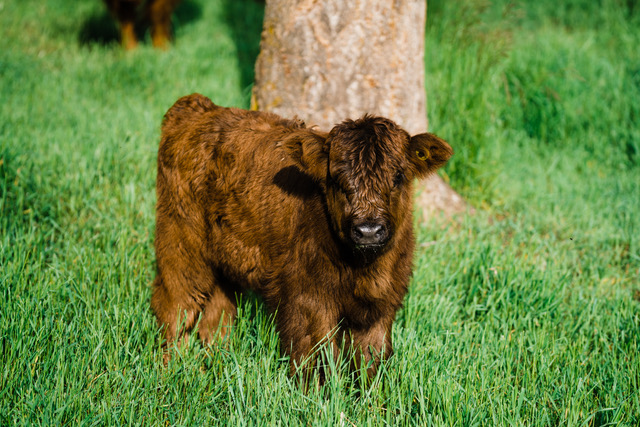
Easy calving
They calve alone with no help, generally giving birth to small calves, averaging 50-75 pounds, but they do grow very quickly once born. If you’re lucky you may witness a birth when you’re here. It’s amazing to see them born, standing and drinking all within half and hour usually.
Hardiness
Highland cattle have a high level of resistance and a surprising ability to survive, sometimes in very difficult conditions. They have a very rustic nature. They have been described as almost as cold-tolerant as the arctic-dwelling caribou and reindeer. They cope with the Canadian winter perfectly, much preferring it to summer. Although we provide sheds they rarely use them, preferring the shelter of trees. They can be prone to respiratory conditions if kept inside and we think they don’t like feeling boxed in, preferring a roof over their heads but open sides to be aware of everything around them.
Their skill in foraging for food allows them to survive in steep mountain areas where they both graze and eat plants that many other cattle avoid. They can thrive in poor pastures. They can dig through the snow with their horns to find buried plants.
To maintain good health we provide lots of fresh water and a supply of minerals – mainly selenium which is near absent from the soil in our region. A selenium deficiency often causes irreparable effects on calves and adult animals. We feel hay in winter and the occasional treat of the spent mash from the local craft brewery, Whitetooth Brewing. Read about that in this earlier Blog.
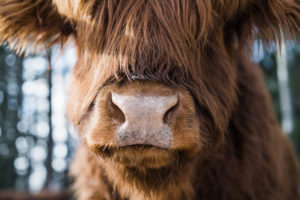
Eco-Friendly
The average Highland cow is smaller and lighter than standard cattle. This means they tread lightly, without destroying the ground for other wildlife species and plants. They are perfect for conservation grazing because they use their tongues to pull the grass so the vegetation is not left too short, and their dung fertilises the ground. When wildflower seeds stick to their long fur and are dropped off in other places they become perfect pollinators.
Naming Highland Cattle
In Canada all pedigree Highland cattle can be registered with the Canadian Highland Cattle Society. Letters are used to designate the year of birth. I, O, Q and V are not used. For example calves born in 2020 were named with a H, 2021 a J, 2022 will be a K. It’s a quick way to tell how old an animal is. All our cattle are registered and thank goodness we only have up to 5 calves to name each year. We always welcome suggestions for names.
Below in the “Our Highland Cattle” section you can see the names and work out the ages of the beauties in our Fold. Read the Fun Facts section below to see why the collective term for a group of Highland Cattle is a Fold rather than a herd.
Our Highland Cattle
Our cattle are all pedigree pure bred Highlanders registered with the Canadian Highland Cattle Society. The collective are registered as The Moffat Fold.
We always like our cows to calve in late Spring when there’s fresh grass on ground for mum to help produce good milk for her babies. In February and March’s baltic temperatures there is the added risk of newborn calves freezing off their ears, poor wee things.
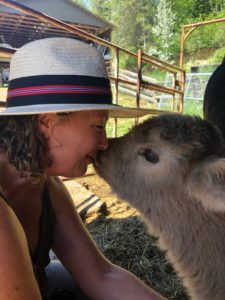
Summer visitors see the calves at their cutest and fluffiest running around in the field in front of the Lodge.
We sell a few cows and bulls each year to various breeders around BC and Alberta. Currently visitors can get to see the following still with us.
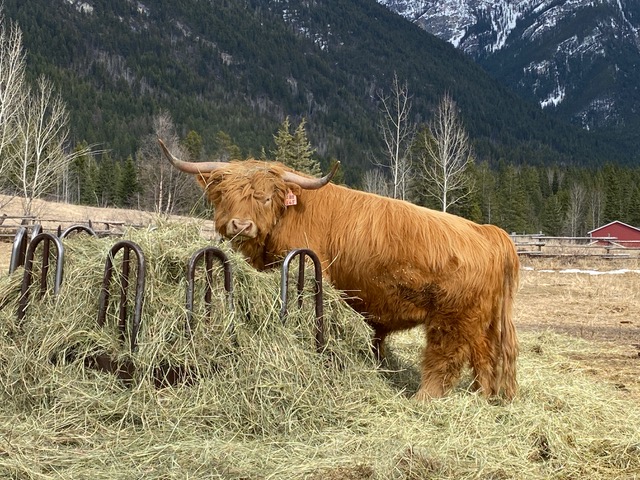
Zebedee, Truffle, Anna, Benjamin Franklin (above in the hay feeder), Elizabeth III, Erinermintrude, Florence, Harris, Henry Douglas, Junebug, Jasper, Jessie, Jojo and Johnny Casanova
Extreme cow watching at Home Lodge
Cow therapy
When we say we’re from Golden people tell us that everything is extreme here: skiing, biking, mountains etc. So we joke that we do extreme cow-watching. Well if doing lots of it is extreme then yes we do. There is so much to be had from just watching and engaging with these 4-legged beauties and we encourage it for all of our guests. Some people call lit cow-therapy: after a stressful week our lovely neighbour comes for some weekend extreme cow watching and brushing.
Cow brushing
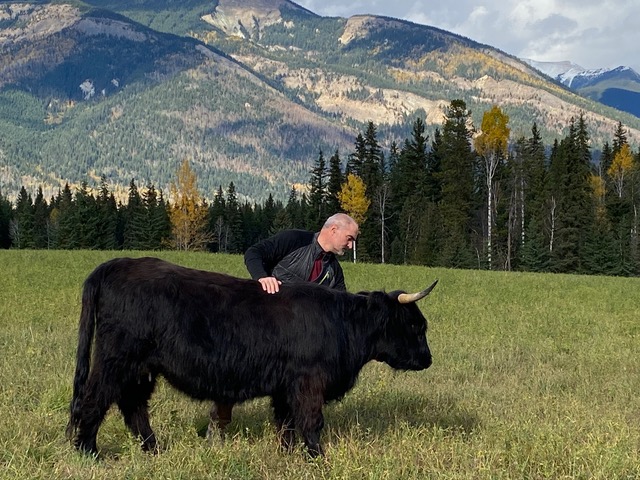
They love to be brushed: specially in spring when shedding their winter coats. Some will almost push you over begging to be brushed. You’ll notice that around the fields we actually have some brushes attached to trees so they can self-brush as the itch arises. Lots of birds take the hair to line their nests.
Head-tussling
From quite a young age you’ll see the mums teaching their calves to tussle with their heads. Head against head it’s an interesting game but is teaching them valuable lessons about asserting their order in the hierarchy. As they grow they challenge other cattle with head tussles to see who’s strongest. The cows don’t really like to be stroked on their heads and the bulls can see it as a challenge if you tap their heads, so if you want to stroke a cow go for the next or under the chin instead.
Fun Facts
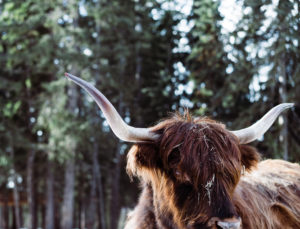
- The collective name for a group of cows is usually a herd. However, a group of Highland cattle is known as a ‘fold’ – named after the open shelters they can be kept in over winter.
- The hairy part that covers their eyes and keeps out the flies and rain is called a dossan
- The Highland Cow is the oldest registered breed of cattle in the world
- Highland meat is high in iron and omega 3, low in fat and lower in cholesterol than chicken
- Originally they were black. The Victorians preferred red so they selectively bred them to the colour known today.

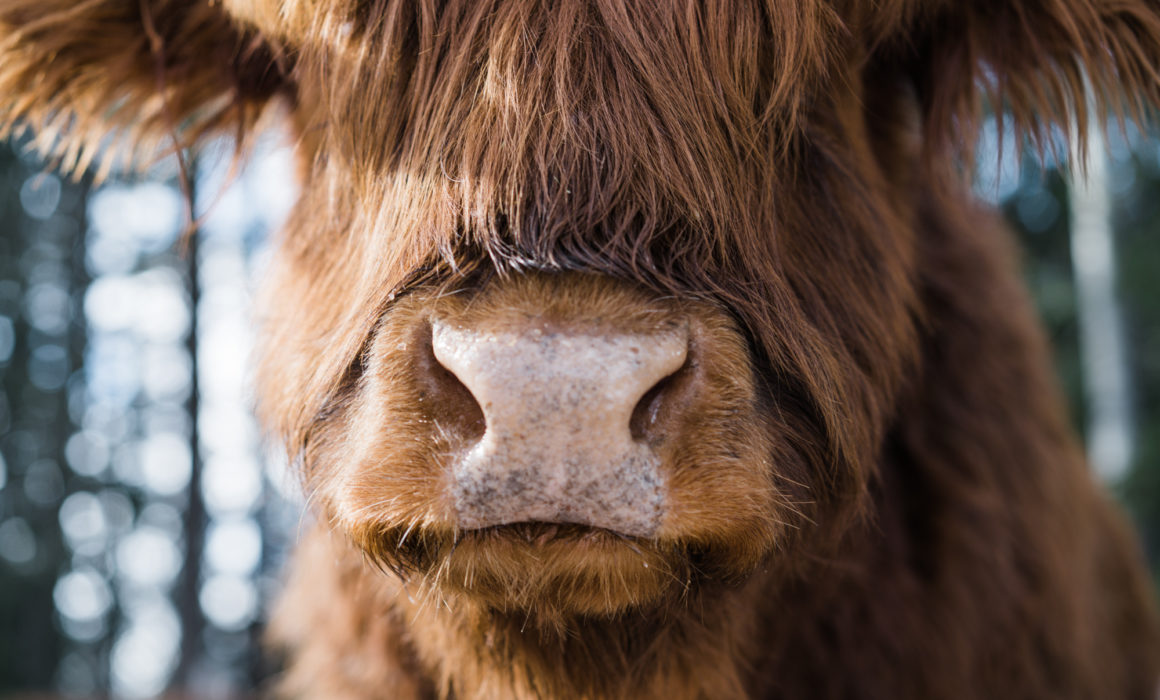
very impressed with the pictures, the information i am new to the highlands . I have 8 cows (3 duns, 3 reds ,2 ginger ) and black bull age 7 years old . and 7 younger at present.